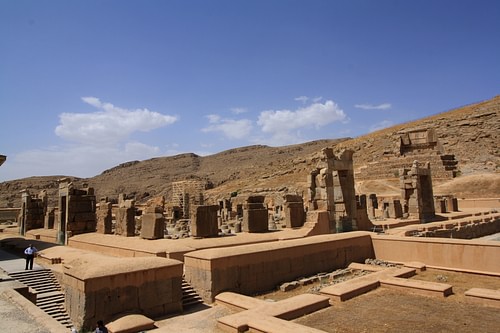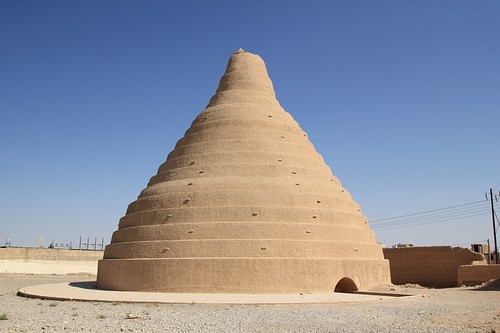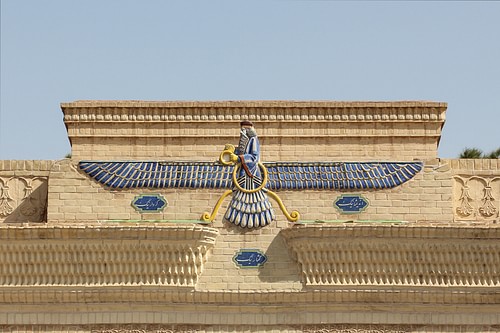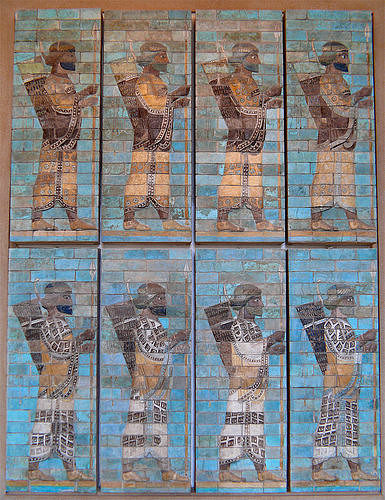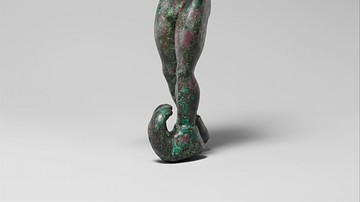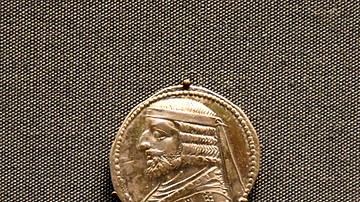Ancient Persian culture exerted a powerful influence throughout the Near East, and beyond, for over a thousand years between c. 550 BCE - 651 CE and many aspects of their culture continued to influence others afterwards and up through the present day.
The first Persian polity was the Achaemenid Empire (c. 550-330 BCE) which fell to Alexander the Great and, after his death, the region was held by the Hellenic Seleucid Empire (312-63 BCE) founded by one of Alexander's generals Seleucus I Nicator (r. 305-281 BCE). Persian culture continued under the Seleucids, however, and again became dominant with the rise of the Parthian Empire (247 BCE-224 CE) and continued, at its greatest height, throughout the Sassanian Empire (224-651 CE) until the Persians were conquered by the invading Muslim Arabs.
From the earliest days of the Achaemenid Empire till the last of the Sassanians, the Persians introduced a number of novel concepts in innovations and inventions which are often taken for granted today or whose origins are largely unknown. Literary motifs, the custom of daily teatime, care for dogs, refrigeration and air conditioning, and many other established aspects of daily modern life originated or were developed by the ancient Persians.
The Persians held to an oral tradition of transmitting information, however, and so much of their history, until the Sassanian period, comes from others. A large part of whatever written records of the Achaemenids did exist was destroyed by Alexander when he burned the capital city of Persepolis in 330 BCE and the Parthians retained the oral tradition of their precursors and so much of Persian history was preserved by the Greeks and, later, the Romans. These writers did not always represent Persian culture accurately but provide enough information, coupled with archaeological evidence and what Persian sources remain, to recognize the power and vision of the culture and its enduring legacy.
Below are ten contributions and historical facts relating to the Persians which are often overlooked or largely unknown. These are only a notable few, however, and do not begin to address the vast scope of Persian achievement.
Persia Is the Greek Name for Iran
The original name for Iran was Airyanam (as per the Avesta, the Zoroastrian scripture of the Persians), also given as Eran and Irania and meaning “land of the Aryans” which refers to the first tribes which settled in the region sometime around the 3rd millennium BCE. Aryan meant “noble” or “free man” and referred to a class of people, not a nationality. One of these Aryan tribes settled in the territory of Persis (also known as Parsa, modern-day Fars), and from Persis, the Greek writer Herodotus (l. c. 484-425/413 BCE) called the people Persians. Later Greek and Roman writers followed Herodotus' lead in this until, in the West, the ancient Iranians were known as Persians.
The region continued to be known as Persia up through the 20th century CE until, in 1935 CE, the Iranian government took the suggestion of Nazi Germany (with whom they had strong diplomatic relations) to officially request the country be recognized as Iran in order to link it with the mistaken concept of Aryan as understood by the Nazi Party. Ancient Iran continues to be known as Persia in the West simply because Western historians continued to use the term, and it differentiates the ancient history of the region from the modern.
Invented First Refrigerator & Air Conditioning
The Persians invented, or developed, the first system of refrigeration, known as a yakhchal. This was a domed structure made of clay, which was used to store ice but, eventually, also came to be used to keep food cold. The invention of the yakhchal is commonly attributed to the reign of the first Achaemenid king Cyrus II (the Great, r.c. 550-530 BCE) but was actually created earlier either by the Persians or the people of nearby Elam who contributed a number of concepts and innovations to Persian culture. The windmill, however, is without doubt a Persian invention, created c. 500 BCE, and led to the development of the ventilation system known as the windcatcher (or wind tower) which was a structure attached to the top of a building, which would draw cool air down, push warm air up, and keep the building a comfortable temperature in hot weather.
Fatalism as Literary Motif
Another Persian invention, often overlooked, is the literary motif of fatalism expressed in the Latin phrase Vitae summa brevis spem nos vetat incohare longam (“The brief sum of life forbids us the hope of enduring long”) which developed out of a sect of Zoroastrianism known as Zorvanism. In Zorvanism, Zorvan was venerated as the God of Infinite Time and, since one could not appeal to time to change one's fate in any way, this belief system gave rise to the concept of fatalism. No matter what one did, one faced inevitable extinction and the span of one's life was already set.
This motif is famously exploited in The Rubaiyat of the Persian poet Omar Khayyam (l. 1048-1131 CE) but was used earlier than his time (and notably by Ferdowsi, l. c. 940-1020 CE, in his Shahnameh), picked up by Greek and Roman writers, and continues up through the present day. It is often the underlying theme of the ubi sunt motif (“where have they gone?”) and informs a number of great literary works. The motif is probably best expressed in the modern era by the lines, “They are not long, the days of wine and roses/Out of a misty dream/Our path emerges for a while, then closes/Within a dream” by the English poet Ernest Dowson (l. 1867-1900 CE), though it has formed the basis for many famous works before and since Dowson's time.
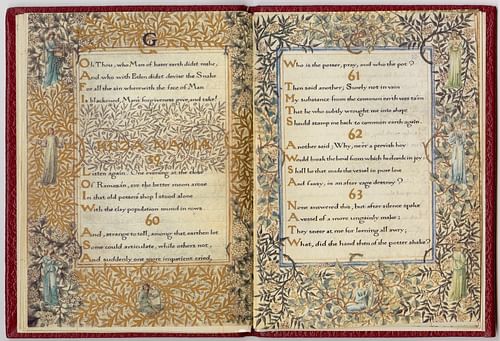
Birthday Celebrations & Dessert
Birthday celebrations began as festivals honoring the king's birth, but the Persians eventually expanded the concept to include everyone and so invented the birthday party. These celebrations included special foods prepared for the guest of honor and a cake served after the meal with lighted candles on it. The cake itself might have been specially prepared for the event but the practice of eating sweets or some other sort of treat after dinner was common after every evening meal. The Greek writers criticized the Persians for this practice, but the Persians considered the Greeks barbaric and simple-minded for not appreciating the value of desserts and thought them uncultured and underfed. The birthday party and concept of dessert both highlight the Persian cultural value of enjoying life while one can and making each day a celebration.
Women's Rights
Although the claim that the Persians were the first in the world to issue a Declaration of Human Rights (via the famous Cyrus Cylinder) has been challenged, there is no disputing the fact that Persian women had more rights and privileges than any other ancient culture except for Egypt. Royal women were treated with the greatest respect while men and women of the lower classes worked the same jobs for the same pay as evidenced by the Fortification and Treasury Texts from the time of Darius I (the Great, r. 522-486 BCE). Women could supervise men on the job, and those with exceptional skills and administrative power were addressed as Arashshara (Great Chief). Women could own land, served in the military (as enlisted, officers, and on the high command in the company of the king), and ran their own businesses. The most popular goddess of the Early Iranian Religion was Anahita who continued to be venerated as an aspect of the god Ahura Mazda once the Persians adopted the monotheism of Zoroastrianism.
Monotheism & Religious Tolerance
The Early Iranian Religion was polytheistic, worshipping many gods who were presided over by Ahura Mazda (Lord of Wisdom), until the prophet Zoroaster (l. c. 1500-1000 BCE) introduced the concept of monotheism. Although the monotheistic construct was embraced by the Egyptian pharaoh Akhenaten (r. 1353-1336 BCE), Zoroaster envisioned the same independently, developed it completely, and established it so firmly that it would endure from his time to the present day. Zoroastrianism recast the earlier polytheistic deities within a monotheistic framework so the former gods and goddesses were now emanations or aspects of the one true god Ahura Mazda who encouraged people to live according to the simple dictum of Good Thoughts, Good Words, Good Deeds which would elevate them and those they interacted with. Even though the Persians believed they had received a genuine revelation from the Divine, however, they never persecuted those of other faiths and all religions were respected throughout the course of all three of their empires.
Truth as the Highest Value
One contributing factor to this tolerance was the Persian cultural value of knowing and telling the truth. Truth was such a vital aspect of Persian culture that it was one of the vows a soldier took upon entering service and the Persian word for truth (asa or arta) appears in a number of Persian names, notably those of kings such as Artaxerxes. Greek writers, who are sometimes – if not often – hostile to Persian values make a point to commend them on this aspect, noting that Persians detested liars and scorned those who were in debt because a debtor was apt to lie to avoid paying back what was owed.
The Persian version of hell was known as The House of Lies and had three levels, the lowest and darkest for the worst of sinners, who, among other transgressions, had lied the most. Believing that their religion was true, they felt no need to impose it on any others since it was clear to them that, in time, people would recognize the truth of Zoroastrianism themselves and embrace it. If not, it was no great matter since they believed that the souls of transgressors or unbelievers were only punished for a certain amount of time in the afterlife before they were welcomed to paradise by Ahura Mazda.
Initiated Military Uniforms & Units
Military units and regiments were a Median invention under their king Cyaxares (r. 625-585 BCE), but Cyrus the Great reformed his model. Cyrus organized the military on the decimal system so that each unit was comprised of ten lesser: 10 men = a company; 10 companies = a battalion; 10 battalions = a division; 10 divisions = a corps. In order to differentiate between units, the Persian command instituted different colored uniforms (yellow, blue, and purple) and regulated signals for communication between corps. As noted, women could serve in the military and some known by name are Artunis (l. c. 540-500 BCE), Pantea Arteshbod (served under Cyrus the Great), who assisted in the formation of the elite unit of the 10,000 Immortals, and Artemisia I of Caria (l. c. 480 BCE), famous for her valor at the Battle of Salamis in 480 BCE.
Conquered Egypt with Cats
The Persians could also be quite innovative in military tactics. In 525 BCE, the Persian king Cambyses II (r. 530-522 BCE) invaded Egypt. Herodotus claims this was in response to an insult by the Egyptian pharaoh but could as easily simply have been a continuation of Cyrus the Great's expansionist policy. He was stopped at the strongly fortified city of Pelusium which he knew he could not take without heavy losses. Cambyses II was well acquainted with Egyptian culture, however, and recognized that their love of animals – especially cats – could be exploited. He had his soldiers paint the image of the Egyptian goddess Bastet (regularly depicted as a cat or a woman with a cat's head) on their shields and, further, rounded up stray animals (including cats) which his army drove before them toward the city. Rather than harm the animals or disrespect the image of Bastet, the Egyptians surrendered, and Cambyses II claimed the country for the Achaemenid Empire.
Postal System & Hospital
The first highly developed postal system was developed by the Persians under Darius I who decreed a network of roads be built for ease of travel and then instituted a service whereby riders could carry messages between his various capitals or encampments. These mounted messengers were provided with stops along the way to refresh themselves and their horses and were so dedicated to their mission that they stopped for nothing. Herodotus praises the Persian postal system in his famous lines, “Whatever the conditions – it may be snowing, raining, blazing hot, or dark – they never fail to complete their assigned journey in the fastest possible time” (Histories, VIII.98). These lines, in modified form, are now the unofficial motto of the United States Postal Service and have been since 1914 CE.
The Persians also initiated the first hospitals beginning under the reign of Shapur I (240-270 CE) who founded the Academy of Gundeshapur, an intellectual and cultural center. The academy welcomed medical professionals and intellectuals of all nationalities and, under the later Sassanian king Kosrau I (r. 531-579 CE) became the first teaching hospital in the world.
Conclusion
In addition to the above, the Persians invented the precursor of the guitar, their stringed instrument known as the sestar, developed the irrigation system of the qanat, still used today to fertilize fields, and contributed various items, or names, well known in the modern day. These include the English word paradise (from their word pairi-daeza for an enclosed, landscaped garden), the sandal, the tapestry, the Persian rug, the word and concept of magic, as well as the name of the lilac bush and tulip. They also popularized tea as a daily drink, the use of incense in ritual, and the care and training of horses and dogs. Dogs were so highly valued by the Persians that one's final destination in the afterlife was determined, in part, by how well – or poorly – one had treated dogs.
When the Sassanian Empire fell to the Muslim Arabs in 651 CE, their culture was at first suppressed and their rituals and traditions outlawed. In time, however, Persian culture was assimilated by the conquerors and spread across the Near East and then beyond. In the 18th century CE, popular European poets and scholars took an interest in the culture and this encouraged wider interest from the West. Presently, two of the most widely read poets in the world are Rumi (l. 1207-1273 CE) and Hafez Shiraz (also known as Hafiz, l. 1315-1390 CE), both Persians, whose works continue to inspire and often serve as an introduction to the vast contributions of their culture.
